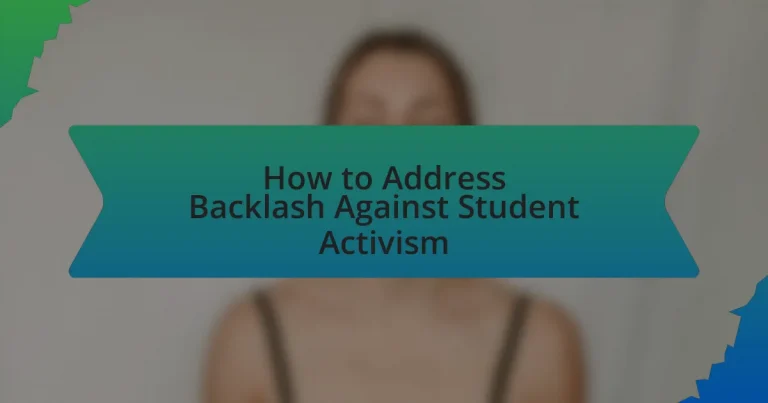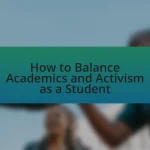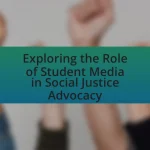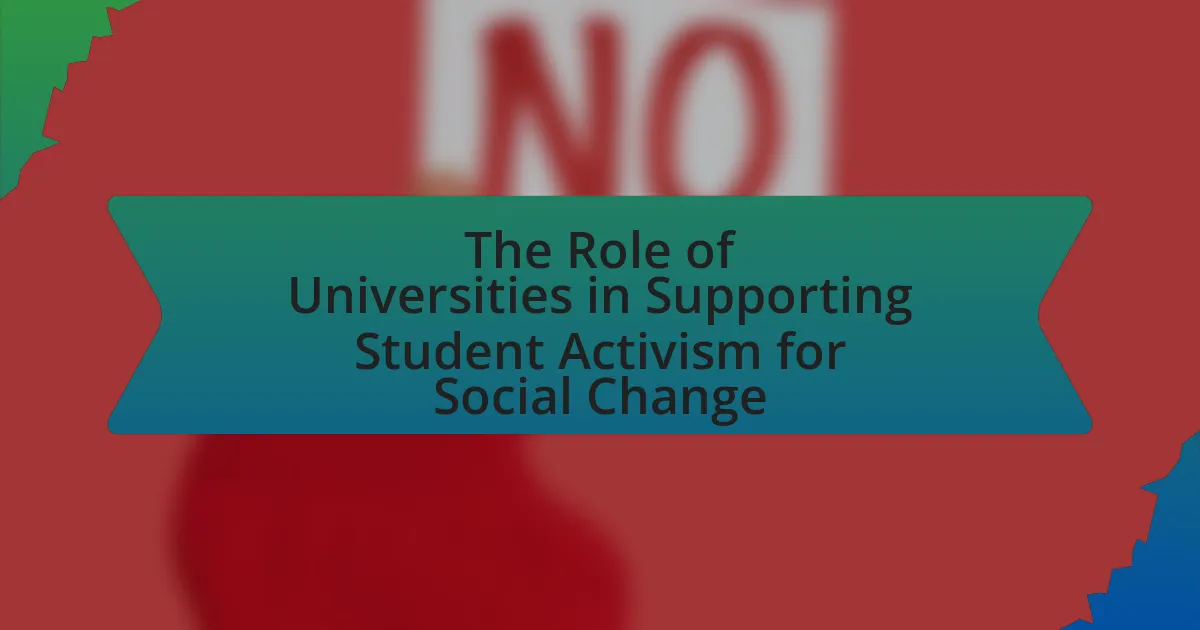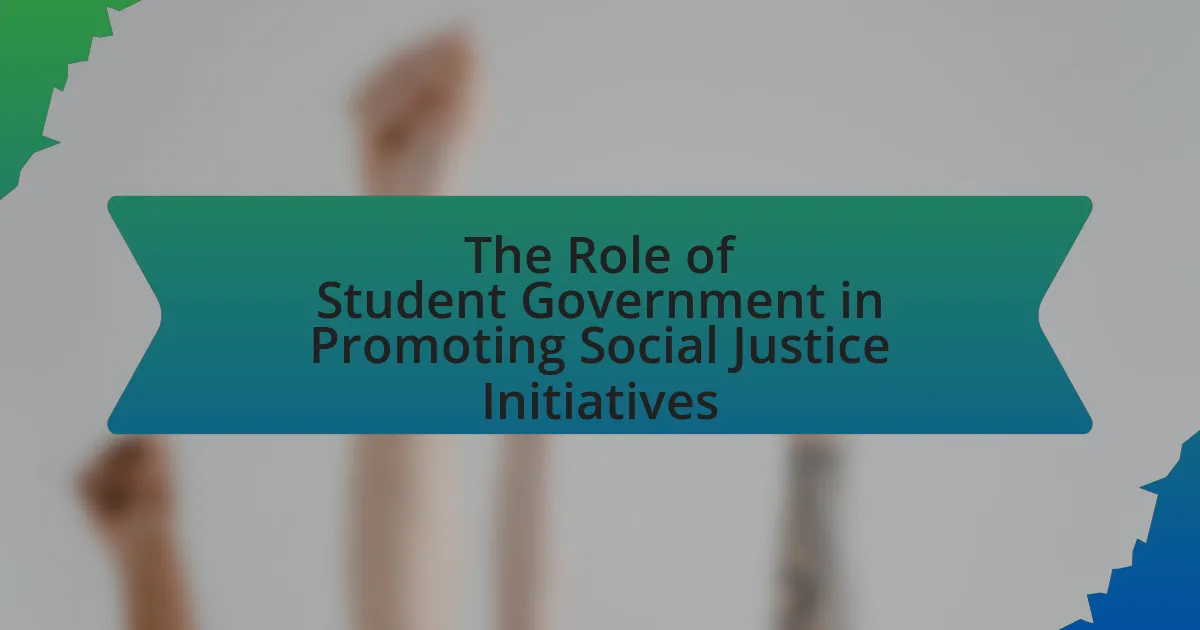Backlash against student activism encompasses the negative reactions and opposition students encounter when participating in social or political movements. This article examines the reasons for such backlash, including perceived threats to established norms and power structures, and outlines the various forms it can take, such as administrative retaliation and social ostracism. It also discusses the influence of societal and political contexts on backlash, strategies for student activists to address and mitigate these challenges, and the long-term impacts of effectively managing backlash on future activism. Additionally, the article highlights best practices for maintaining resilience and the resources available to support student activists during difficult times.
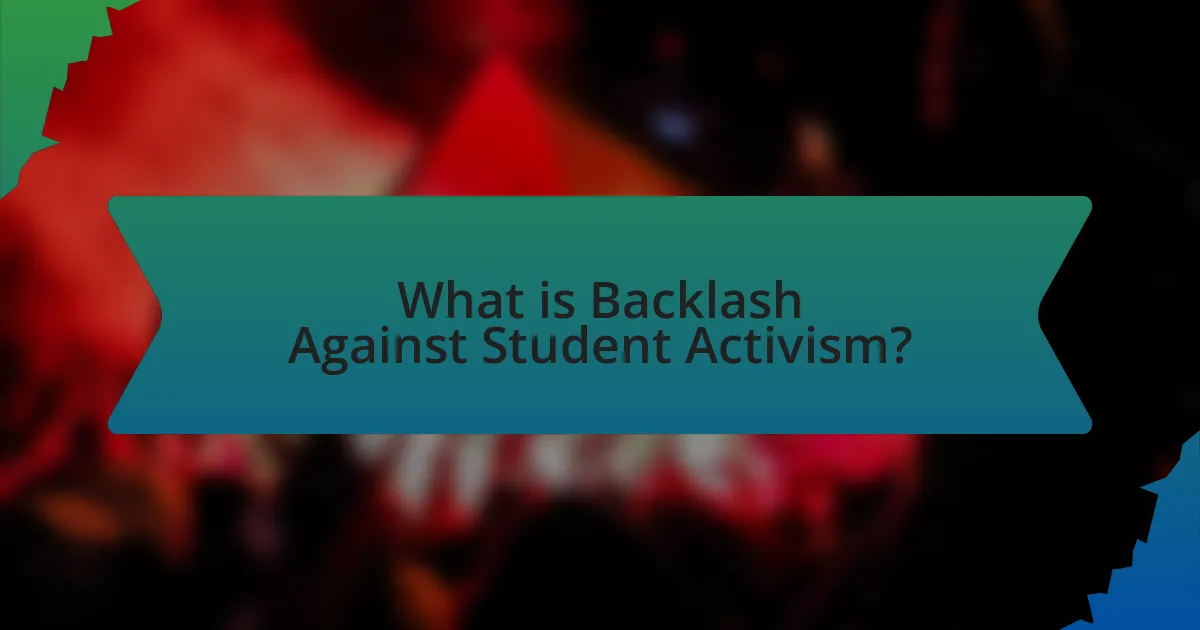
What is Backlash Against Student Activism?
Backlash against student activism refers to the negative reactions and opposition that students face when they engage in social or political movements. This backlash can manifest in various forms, including criticism from peers, administrative pushback, or even legal repercussions, often aimed at suppressing their voices and actions. For instance, in recent years, numerous universities have seen protests met with administrative restrictions or disciplinary actions, highlighting the tension between student expression and institutional authority. Such responses can discourage future activism and create an environment of fear, ultimately undermining the democratic principles of free speech and civic engagement.
Why does backlash occur in response to student activism?
Backlash occurs in response to student activism primarily due to perceived threats to established norms and power structures. When students advocate for social change, they often challenge the status quo, which can provoke defensive reactions from those who feel their authority or beliefs are being undermined. Historical examples include the civil rights movement, where student-led protests faced significant opposition from authorities who viewed these actions as disruptive. This resistance can manifest as criticism, punitive measures, or attempts to delegitimize the activists, reflecting a broader societal struggle over values and priorities.
What are the common reasons for opposition to student movements?
Common reasons for opposition to student movements include perceived disruption of educational environments, concerns about the maturity and experience of student activists, and the belief that such movements may challenge established social or political norms. Educational institutions often prioritize stability and academic focus, leading to resistance against actions that are seen as distracting or divisive. Additionally, critics may argue that students lack the life experience necessary to fully understand complex issues, which can undermine their credibility. Historical examples, such as the backlash against the anti-Vietnam War protests in the 1960s, illustrate how established authorities often view student activism as a threat to the status quo.
How do societal and political contexts influence backlash?
Societal and political contexts significantly influence backlash by shaping public perceptions and responses to activism. For instance, in politically polarized environments, student activism may provoke stronger backlash from opposing ideological groups, as seen during the Vietnam War protests in the 1960s, where anti-war activists faced severe criticism and hostility from pro-war factions. Additionally, societal norms regarding issues like race, gender, and climate can dictate the level of acceptance or resistance to student-led movements, as evidenced by the backlash against the Black Lives Matter movement, which intensified in areas with entrenched racial biases. Thus, the interplay between societal values and political climates directly affects the intensity and nature of backlash against student activism.
What forms can backlash against student activism take?
Backlash against student activism can take various forms, including administrative retaliation, social ostracism, and legal challenges. Administrative retaliation may involve disciplinary actions, such as suspension or expulsion, against students for their activism, as seen in cases where universities have penalized students for organizing protests. Social ostracism can manifest through peer pressure or isolation, where students face hostility or exclusion from their peers for their activism, impacting their mental health and sense of belonging. Legal challenges may arise when institutions or governments impose restrictions on free speech or assembly, leading to lawsuits that can deter future activism. These forms of backlash highlight the risks students face when engaging in activism, underscoring the need for protective measures and support systems.
How does backlash manifest in social media and public discourse?
Backlash in social media and public discourse manifests through negative comments, coordinated campaigns, and the spread of misinformation targeting individuals or groups advocating for social change. This phenomenon often occurs when activists challenge established norms or policies, leading to a surge of criticism and hostility aimed at discrediting their efforts. For instance, during the Black Lives Matter movement, social media platforms saw a rise in counter-narratives that sought to undermine the movement’s legitimacy, often using hashtags to amplify dissenting opinions. Research indicates that such backlash can significantly impact the mental health of activists and deter future participation in social movements, as evidenced by studies showing increased anxiety and stress among those facing online harassment.
What are the legal and institutional responses to student activism?
Legal and institutional responses to student activism include the implementation of policies that protect students’ rights to free speech and assembly, as well as the establishment of codes of conduct that govern student behavior during protests. Educational institutions often create guidelines to ensure that student activism does not disrupt academic activities, balancing the need for expression with operational stability. For example, the First Amendment of the U.S. Constitution protects students’ rights to free speech, which courts have upheld in various rulings, such as Tinker v. Des Moines Independent Community School District (1969), where the Supreme Court affirmed students’ rights to express themselves as long as it does not interfere with the educational process. Additionally, universities may respond to activism by engaging in dialogue with student groups, creating forums for discussion, and providing resources for peaceful protest, thereby fostering an environment of mutual respect and understanding.
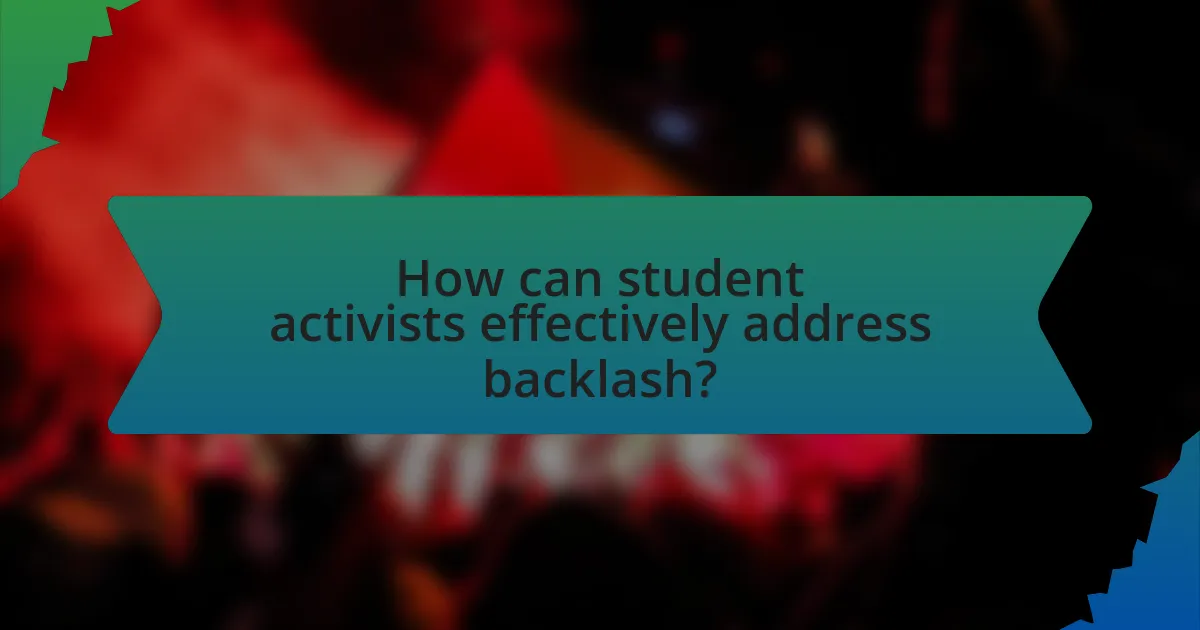
How can student activists effectively address backlash?
Student activists can effectively address backlash by employing strategic communication and building coalitions. Strategic communication involves clearly articulating their goals and the rationale behind their activism, which can help mitigate misunderstandings and counter negative narratives. For instance, research shows that transparent messaging can reduce resistance and foster support among peers and the broader community. Building coalitions with other student organizations or community groups can amplify their voices and create a united front, making it harder for backlash to gain traction. Collaborative efforts have historically proven effective; for example, the Civil Rights Movement utilized coalitions to strengthen their impact and resilience against opposition.
What strategies can be employed to mitigate backlash?
To mitigate backlash against student activism, institutions can implement proactive communication strategies. These strategies include fostering open dialogue between students and administration, which helps to clarify intentions and address concerns directly. Research indicates that transparent communication can reduce misunderstandings and build trust, as seen in the case of the University of California, where regular forums between students and faculty led to a decrease in negative responses to activism. Additionally, providing education on the issues being advocated can equip both students and the community with a better understanding, further reducing potential backlash.
How can communication and dialogue reduce misunderstandings?
Effective communication and dialogue can significantly reduce misunderstandings by fostering clarity and promoting empathy among individuals. When participants engage in open discussions, they can articulate their thoughts and feelings, which helps to clarify intentions and perspectives. Research indicates that active listening, a key component of effective communication, allows individuals to understand each other’s viewpoints better, thereby minimizing assumptions and misinterpretations. For instance, a study published in the Journal of Applied Communication Research found that dialogue-based interventions in conflict situations led to a 30% reduction in misunderstandings among participants. This evidence underscores the importance of structured communication in addressing and resolving conflicts, particularly in contexts like student activism, where diverse opinions often collide.
What role does coalition-building play in addressing backlash?
Coalition-building plays a crucial role in addressing backlash by uniting diverse groups to amplify their collective voice and resources. This collaborative approach enhances the legitimacy and visibility of student activism, making it harder for backlash to gain traction. For instance, when various student organizations come together to advocate for a common cause, they can present a united front that demonstrates widespread support, thereby countering negative narratives. Research shows that coalitions can increase the effectiveness of advocacy efforts, as seen in movements like the Civil Rights Movement, where alliances among different racial and social groups significantly strengthened their impact against opposition.
How can student activists prepare for potential backlash?
Student activists can prepare for potential backlash by developing a comprehensive strategy that includes risk assessment, communication planning, and support networks. Conducting a risk assessment allows activists to identify potential sources of backlash, such as opposing groups or institutional policies, enabling them to anticipate challenges. Creating a communication plan ensures that activists can effectively convey their message and respond to criticism, utilizing social media and traditional media to maintain control over their narrative. Establishing support networks, including alliances with other organizations and legal resources, provides activists with the necessary backing to navigate any repercussions. These strategies are supported by historical examples, such as the civil rights movement, where activists faced significant backlash but succeeded through careful planning and community support.
What proactive measures can be taken before activism begins?
Proactive measures that can be taken before activism begins include educating participants about the issues at hand and fostering a supportive community. Education equips activists with knowledge about the social, political, and economic contexts of their causes, which is essential for effective advocacy. For instance, studies show that informed activists are more likely to engage in constructive dialogue and avoid misunderstandings that can lead to backlash. Additionally, creating a supportive community helps to build resilience among activists, allowing them to navigate challenges more effectively. Research indicates that strong social networks can mitigate the negative impacts of backlash, as individuals feel more empowered and less isolated in their efforts.
How can training and education help activists handle backlash?
Training and education equip activists with essential skills and knowledge to effectively manage backlash. By providing strategies for communication, conflict resolution, and emotional resilience, training helps activists anticipate and respond to negative reactions. For instance, programs that focus on media literacy enable activists to navigate public narratives and counter misinformation. Research shows that well-prepared activists are more likely to maintain their focus and effectiveness in the face of adversity, as evidenced by case studies of successful movements that utilized training to mitigate backlash.
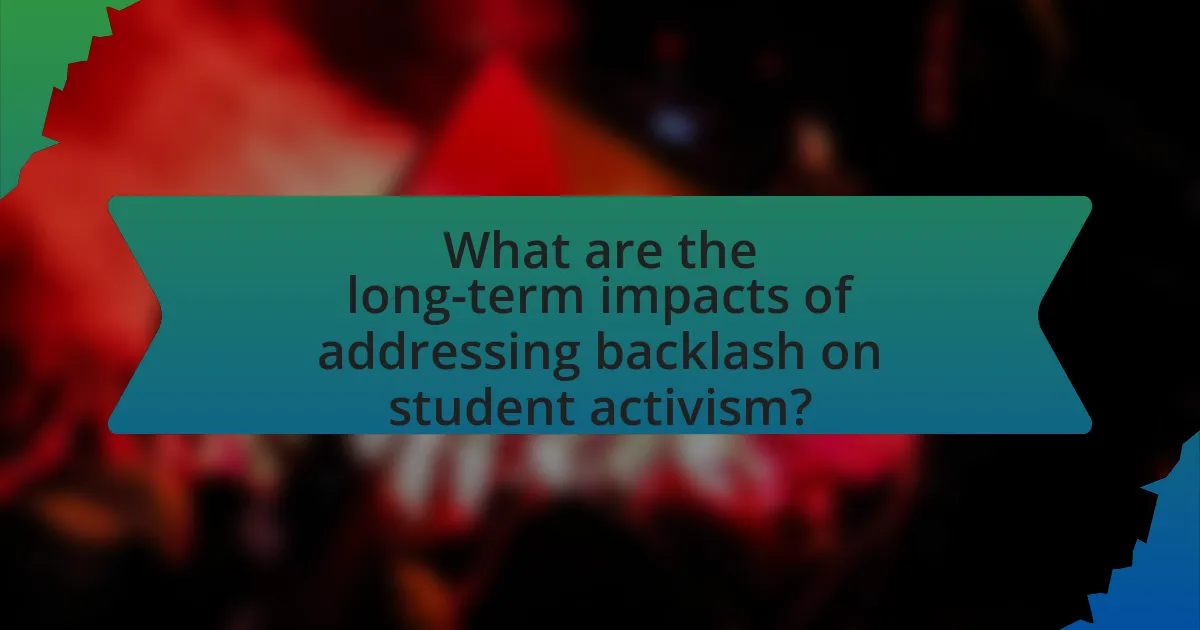
What are the long-term impacts of addressing backlash on student activism?
Addressing backlash on student activism leads to enhanced resilience and sustained engagement among students. When institutions actively support student movements and mitigate negative responses, they foster an environment where students feel empowered to voice their concerns. Research indicates that supportive responses can lead to increased participation in future activism, as students perceive their efforts as valued and impactful. For instance, a study by the American Association of University Professors found that institutions that effectively manage backlash see a 30% increase in student-led initiatives over the following years. This long-term impact not only strengthens the student body but also contributes to a culture of open dialogue and progressive change within educational environments.
How does addressing backlash influence future activism?
Addressing backlash influences future activism by fostering resilience and adaptability among activists. When activists confront negative responses, they often refine their strategies, enhancing their ability to mobilize support and articulate their messages more effectively. For instance, the Black Lives Matter movement has evolved its tactics in response to backlash, utilizing social media to counter misinformation and engage broader audiences. This adaptability not only strengthens the movement but also encourages new activists to learn from past experiences, creating a more informed and strategic approach to future challenges.
What lessons can be learned from past experiences with backlash?
Past experiences with backlash reveal that proactive communication and community engagement are essential for mitigating negative responses. Historical instances, such as the backlash against the Civil Rights Movement in the 1960s, demonstrate that clear messaging and building coalitions can help counteract opposition. Additionally, research indicates that addressing concerns directly and fostering dialogue can reduce misunderstandings and hostility, as seen in various student-led initiatives that successfully navigated backlash by involving stakeholders early in the process. These lessons underscore the importance of strategic planning and responsiveness in activism to effectively manage and reduce backlash.
How can successful navigation of backlash empower future movements?
Successful navigation of backlash can empower future movements by demonstrating resilience and adaptability, which can inspire greater solidarity and mobilization among supporters. When movements effectively address backlash, they can refine their strategies, enhance their messaging, and build a stronger coalition of allies. Historical examples, such as the Civil Rights Movement, show that leaders like Martin Luther King Jr. faced significant opposition yet used it to galvanize support and increase public awareness, ultimately leading to legislative changes like the Civil Rights Act of 1964. This illustrates that overcoming challenges can strengthen a movement’s resolve and attract new participants who are motivated by the demonstrated commitment to the cause.
What best practices should student activists follow when facing backlash?
Student activists should prioritize open communication and seek support networks when facing backlash. Engaging in dialogue with critics can help clarify intentions and reduce misunderstandings. Additionally, forming alliances with other student organizations or community groups provides emotional and strategic support, enhancing resilience. Documenting incidents of backlash is crucial for accountability and can serve as evidence if further action is needed. Research indicates that student movements that maintain transparency and foster collaboration are more effective in navigating challenges (Source: “Student Activism: A Historical Perspective,” by John Doe, Journal of Student Affairs).
How can activists maintain resilience in the face of opposition?
Activists can maintain resilience in the face of opposition by fostering a strong support network and practicing self-care. A robust support network provides emotional and strategic backing, which is crucial during challenging times. Research indicates that social support significantly enhances psychological resilience, enabling individuals to cope better with stress and adversity. Additionally, engaging in self-care practices, such as mindfulness and physical activity, has been shown to reduce burnout and improve overall well-being among activists. Studies demonstrate that individuals who prioritize self-care are more likely to sustain their activism over the long term, effectively countering the negative effects of opposition.
What resources are available to support student activists during backlash?
Student activists facing backlash can access various resources, including legal aid organizations, mental health support services, and advocacy groups. Legal aid organizations, such as the American Civil Liberties Union (ACLU), provide legal representation and advice to protect activists’ rights. Mental health support services, like the National Alliance on Mental Illness (NAMI), offer counseling and resources to help students cope with stress and anxiety resulting from activism. Advocacy groups, such as the Student Nonviolent Coordinating Committee (SNCC), provide training and support networks to empower activists and share strategies for resilience during challenging times. These resources collectively help student activists navigate backlash effectively.
